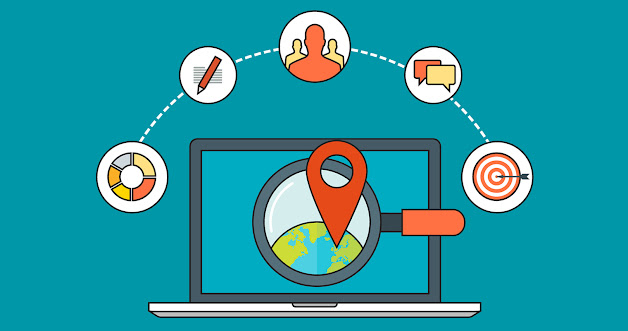
With the help of this guide on local SEO, you can learn how
Google interacts with local sites and begin optimising your website for local
search results to expand your business.
local SEO is a search engine optimization (SEO) strategy
that helps your business be more visible in local search results on Google.

Any business that has a physical location or serves a
geographic area can benefit from local SEO. If you search Google for any
important keywords related to your business and a map with 3 listings appears
underneath it (also known as a map pack), then local SEO can help you grow your
business.
But to understand local SEO, you need to know how Google
works first.
How did search engines change throughout time?
Because there were so few websites in the beginning of the
internet, using it was simple. However, as the internet grew, search engines
were developed to help users more quickly find the websites they were looking
for.
A search engine would match a term you typed to webpages that included the keywords in your search phrase. Google used a similar strategy, but it swiftly overtook the competition when it was the first to use links between websites to determine which ones were reliable and authoritative.
Today Google looks at hundreds of factors both on and off
your website to determine if it’s relevant to display as a search result. Factors form your “digital footprint,” and each factor has
a different weight or value, which the search engine combines to return
results. Your digital footprint determines whether or not you’re a top result
to an inquiry that a user types into Google.
To assess whether a website is relevant to display as a
search result, Google now takes into account hundreds of factors, both on and
off your website. Your "digital footprint" is made up of various
factors, each of which has a unique weight or value that the search engine
combines to produce results. Whether or whether you appear in Google's top
search results depends on your digital footprint.
How then
does Google operate?
In order to return a list of websites that match your
search, Google analyses the pattern of several website signals, or ranking
variables, such how relevant your site is, when you enter a search term.
Most people are unaware that when they type something into
Google's search bar, it doesn't immediately perform a live search of the entire
internet. Actually, it's searching a cached duplicate of every site that Google
has found. The Google Index is the name of this replica.

Google uses "spiders," which are tiny programmes
that crawl the web to create the index. Every spider operates in the same
manner: it begins on a single page, follows the links on that page, then scans
the information on subsequent pages, and so forth.
As web content is crawled, Google's servers store it, and an
index is created. The size of the spiders' labour is astounding; they
continuously crawl trillions of pages at an exceedingly quick rate. By doing
this, the index is kept as current as possible and new websites and links are
found rapidly.
How Google
ranks search results?
Google uses various processes to rank hundreds or thousands
of sites in the blink of an eye. These processes are called algorithms. When
you Google something, an algorithm checks the index and returns a list of
websites that match your search in organic results. Those results are chosen
and ranked based on relevance, prominence and popularity given by inbound links.
how search
results are ranked by Google
Google ranks hundreds or thousands of websites instantly
using a variety of techniques. These operations are referred to as algorithms.
When a user searches for something on Google, an algorithm scans the index and
displays a list of pages that are relevant to their search in organic results.
Based on the relevance, importance, and popularity provided by inbound links,
those results are selected and ranked.
The algorithm examines a number of both on- and off-site variables
to decide whether websites provide content pertinent to your search. The list
is expanded to include all pertinent websites, and it is then ordered by
prominence. The algorithm chooses which websites best respond to your search
query, once more referring to the many on-site and off-site parameters, and
those websites are presented at the top of the search results.
Enhancing your SEO affects your website's relevance,
prominence, and link popularity aspects. If the appropriate digital footprint
components are optimised, your site will appear higher in more search results.
Local SEO follows a unique pattern.
How about the outcomes of local organic searches? Google
discovered that individuals looking for particular sorts of companies
need local results after examining user behaviour throughout trillions of
searches. The proximity factor, which is a fancy way of saying that Google
considers your location when you search for a local keyword, is part of
Google's local search algorithm as a result (a query with local intent). Even
when the searcher excludes a city name or "near me," this still
occurs.
For instance, when you search for "pizza delivery"
while at work, a list of restaurants close to your workplace is displayed in
the local SERPS (search engine result pages).
But if you conduct the same search at home, the outcomes
will be completely different. Given that you require a local pizza delivery,
this makes sense.
Local search has been available for some time, but its use
was restricted because most people exclusively used desktop computers. Local
SEO has become crucial for the success of any company supplying local products
or services as well as local marketers due to the recent explosion in mobile
internet connectivity.
.jpg)
Things to
consider for local SEO
For search marketers, what does this mean? The primary
Google search results for local rankings and the local map pack results are
powered by different algorithms, even though the local map pack is featured
within the usual Google organic search listings. As a local company, you have
the chance to simultaneously show up in the local map pack and the primary
organic search results.
Knowing what to concentrate on to make your efforts as
effective as possible can be difficult if you're new to marketing your business
online.
The top 35 to 40 international authorities in local SEO
participate in the annual Local Search Ranking Factors survey, which is
published by marketing analytics software company Moz. The finest information
about the variables that affect local search visibility can be found in its
results.
Additionally, location-based elements like having a Google
My Business listing for your company, local citations from data aggregators,
and review signals—which should be published by your local customers—are also
taken into account in your local SEO rankings, so you should also take them
into account in your local SEO efforts.
It's also crucial to keep in mind that there are SEO tools designed specifically for local search that can assist you in creating localised SEO audits. These tools range from developing keyword research targeted at your local audience to building citations, managing Google My Business listings, business profiles, and Google posts, and even monitoring your inclusion in local packs

begin
utilising SEO
You may start focusing on signals that will improve your
site's digital presence in the local oriented search ecosystem now that you
have a better understanding of SEO fundamentals and how Google ranks local
search results. By doing this, your company will appear higher on the results
page, increasing the likelihood that more potential customers will find it.

.jpeg)




.jpeg)
No comments:
Post a Comment